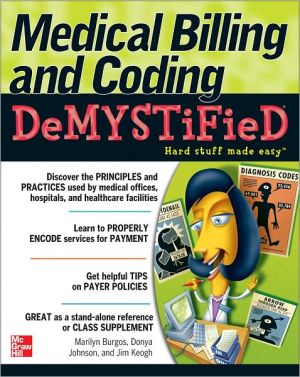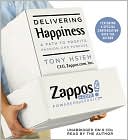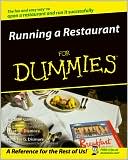Keys to Medical Assisting: A Pocket Guide
Designed as a quick reference for students in their externship and medical assistants on the job, Pocket Guide for Medical Assistants is the perfect tool for success! Highlighting both the administrative and clinical daily tasks of the medical assistant, this is the complete pocket guide at your fingertips. Each section summarizes the steps required for administrative, clinical, and laboratory procedures that the medical assistant must know. As an added bonus the fire proof, water proof, and...
Search in google:
Designed as a quick reference for students in their externship and medical assistants on the job, Pocket Guide for Medical Assistants is the perfect tool for success! Highlighting both the administrative and clinical daily tasks of the medical assistant, this is the complete pocket guide at your fingertips. Each section summarizes the steps required for administrative, clinical, and laboratory procedures that the medical assistant must know. As an added bonus the fire proof, water proof, and tear resistant paper allows you to take this pocket guide anywhere!
Brief Table of ContentsSection I Administrative Medical AssistingChapter 1 General Medical Office DutiesChapter 2 Appointment SchedulingChapter 3 Mail Processing and Managing CorrespondenceChapter 4 Medical Records ManagementChapter 5 CommunicationSection II Financial ManagementChapter 6 Purchasing and Banking for the Medical OfficeChapter 7 Health InsuranceChapter 8 Medical CodingSection III Clinical Medical AssistingChapter 9 Infection Control and Principles of AsepsisChapter 10 Minor SurgeryChapter 11 Vital Signs and Preparing the PatientChapter 12 ElectrocardiographyChapter 13 RadiologyChapter 14 Medical EmergenciesSection IV Basic Pharmacology and Administration of MedicationsChapter 15 Introduction to PharmacologyChapter 16 Drug CalculationsChapter 17 Administering MedicationsSection V Laboratory ProceduresChapter 18 Phlebotomy and HematologyChapter 19 Medical MicrobiologyChapter 20 UrinalysisAppendicesAppendix A Abbreviations and SymbolsAppendix B Commonly Misspelled Medical TermsAppendix C Frequently Used Computer TermsAppendix D Proofreader’s MarksAppendix E Rules for Alphabetic FilingAppendix F Anatomy of MyPyramidAppendix G Vitamins and MineralsAppendix H CMA ExaminationAppendix I Laboratory Requisition FormAppendix J Normal Laboratory Test ValuesAppendix K Overview of Body Systems and their FunctionsAppendix L Celsius and Fahrenheit Temperature EquivalentsAppendix M Apothecary/Household/Metric EquivalentsAppendix N Immunizations and VaccinationsAppendix O Blood GroupingAppendix P Patient’s Bill of RightsExpanded Table of ContentsSection I Administrative Medical AssistingChapter 1 General Medical Office Duties-Reception AreaTelephone TechniquesChapter 2 Appointment SchedulingAppointment TypesScheduling SystemsScheduling ProcessEmergency AppointmentsNew Patient AppointmentsChapter 3 Mail Processing and Managing CorrespondenceProcedure 3-1: Opening the MailBusiness LettersMail Needing Special HandlingOutgoing MailChapter 4 Medical Records ManagementThe Importance of Medical RecordsElectronic Medical RecordsRecords ManagementFiling SystemsChapter 5 CommunicationTypes of CommunicationCommunicating with Special PatientsCommunicating with CoworkersPolicy and Procedures ManualSection II Financial ManagementChapter 6 Purchasing and Banking for the Medical OfficeDurable ItemsConsumable ItemsSuppliesBanking FunctionsChapter 7 Health InsuranceBilling and Reimbursement CycleHealth InsuranceMedical Insurance PayersHealthcare Claims Forms and TransmissionHIPAA Privacy RulePreauthorizationChapter 8 Medical CodingDiagnosis Codes (the ICD-9-CM)Procedure 8-1: ICD-9-CM CodingProcedure Codes (CPT)Healthcare Common Procedure Coding System (HCPCS) SectionsSuperbillsSection III Clinical Medical AssistingChapter 9 Infection Control and Principles of AsepsisThe Chain of InfectionPrinciples of AsepsisMedical AsepsisProcedure 9-1: Hand HygieneSurgical AsepsisProcedure 9-2: Surgical ScrubbingBloodborne Pathogens and Safety IssuesChapter 10 Minor SurgeryThe Role of Medical Assistants in Minor SurgeryClassifications of Surgical InstrumentsSurgical SetupSuture RemovalSpecial Surgical ProceduresChapter 11 Vital Signs and Preparing the PatientFactors Affecting Vital SignsNormal Vital Signs in Pediatric PatientsTemperaturePulseRespiration RateBlood PressureThe Patient Exam and PositioningChapter 12 ElectrocardiographyThe ElectrocardiogramHolter MonitorTreadmill Stress TestChapter 13 RadiologyRadiologyCommon Radiological Imaging ExaminationsPreparing the PatientProcedure 13-1: Assisting with an X-ray ExaminationRadiation SafetyChapter 14 Medical EmergenciesBasic Life SupportCPR for AdultsProcedure 14-1: CPR for UnresponsivenessProcedure 14-2: CPR for CirculationProcedure 14-3: CPR for AirwayProcedure 14-4: CPR for Rescue BreathingAutomated External DefibrillatorsProcedure 14-5: Using an AEDCPR for ChildrenProcedure 14-6: Administering CPR to ChildrenHeimlich Maneuver for ChokingBurnsBone FracturesPoisoningSection IV Basic Pharmacology and Administration of MedicationsChapter 15 Introduction to PharmacologyPharmacokineticsPharmacodynamicsDrug NamesGovernment RegulationsDrug ClassificationsDrug Information SourcesStorage of DrugsChapter 16 Drug CalculationsMeasurement SystemsBasic MathDrug Dosage CalculationsChapter 17 Administering MedicationsTen Rights of Drug AdministrationGuidelines for Drug AdministrationRoute of AdministrationAdministering VaccinesSection V Laboratory ProceduresChapter 18 Phlebotomy and HematologyProcedure 18-1: VenipunctureAccidental Needle StickStandard PrecautionsStoppered TubesProcedure 18-2: Butterfly MethodProcedure 18-3: Capillary PunctureOrder of Drawing BloodHematologyProcedure 18-4: Differential White Blood Cell CountsProcedure 18-5: Hemoglobin MeasurementProcedure 18-6: Hematocrit MeasurementProcedure 18-7: Erythrocyte Sedimentation RateProcedure 18-8: Bleeding TimeChapter 19 Medical MicrobiologyClassifications of MicroorganismsMethods of IdentificationProcedure 19-1: Performing a Gram StainCollecting SpecimensCulture MediaProcedure 19-2: Direct SmearProcedure 19-3: Wet Mount PreparationProcedures Performed in the Physician’s Office LaboratoryProcedure 19-4: Throat Culture of Streptococcus PyogenesProcedure 19-5: Rapid Strep TestChapter 20 UrinalysisComposition of Normal UrineCommon Urine TestsGuidelines for Collecting a Routine Urine SampleProcedure 20-1: Collecting a Clan-Catch SpecimenProcedure 20-2: Physical UrinalysisProcedure 20-3: Measuring Specific GravityProcedure 20-4: Testing Urine with Reagent StripsMicroscopic Urine SampleProcedure 20-5: Urine Pregnancy Testing AppendicesAppendix A Abbreviations and SymbolsAppendix B Commonly Misspelled Medical TermsAppendix C Frequently Used Computer TermsAppendix D Proofreader’s MarksAppendix E Rules for Alphabetic FilingAppendix F Anatomy of MyPyramidAppendix G Vitamins and MineralsAppendix H CMA ExaminationAppendix I Laboratory Requisition FormAppendix J Normal Laboratory Test ValuesAppendix K Overview of Body Systems and their FunctionsAppendix L Celsius and Fahrenheit Temperature EquivalentsAppendix M Apothecary/Household/Metric EquivalentsAppendix N Immunizations and VaccinationsAppendix O Blood GroupingAppendix P Patient’s Bill of Rights








